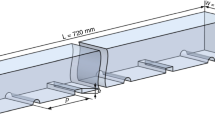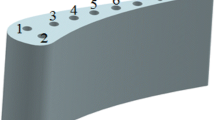Abstract
A CFD-based multi-objective optimization is performed for improving the film cooling performance of the laidback fan-shaped holes on the suction surface of a turbine guide vane under a typical blowing ratio of M = 1.5. Among the main geometric parameters, the inclination angle (α), lateral expansion angle (β) and forward expansion angle (γ) are selected as the design variables, with respective lower and upper bounds of (25°, 55°), (10°, 20°) and (3°, 15°) in turns. Two independent objective functions that are simultaneously optimized are selected as the spatially-averaged adiabatic film cooling effectiveness (ranging from s/d = 0 to s/d = 12) and the discharge coefficient. By using a variant of non-dominated sorting genetic algorithm (NSGA-II) coupled with the RBFNN-based surrogate model, the Pareto front of optimal solutions is obtained, providing a variety of options for seeking the maximum spatially-averaged adiabatic film cooling effectiveness, the maximum discharge coefficient, or the compromise of both aspects. The optimized results show that the optimal geometers of (α, β, γ) are (50.3°, 19.5°, 9.8°), (25°, 18.7°, 11.8°) and (27.3°, 19°, 5.1°) for achieving the most maximum film cooling effectiveness, the most maximum discharge coefficient and the compromise of both aspects, respectively. In general, a large lateral expansion angle of the laidback fan-shaped film-cooling hole is necessary in the shape optimization for all of the optimal options. However, with regard to the other design variables, their selections are very distinct following the optimal option. Further, the influence role of optimal fan-shaped geometry on the film cooling performance is illustrated according to the detailed flow and thermal behaviors.













Similar content being viewed by others
Abbreviations
- C :
-
Chord length (m)
- C d :
-
Discharge coefficient
- c p :
-
Static pressure coefficient
- C x :
-
Axial chord length (m)
- d :
-
Film hole diameter (m)
- F 1 :
-
Fitness function of spatially-averaged adiabatic film cooling effectiveness
- F 2 :
-
Fitness function of discharge coefficient
- k :
-
Ratio of specific heats
- l 1 :
-
Length of cylindrical section (m)
- l 2 :
-
Length of lateral expansion section (m)
- l 3 :
-
Length of forward expansion section (m)
- M :
-
Blowing ratio
- Ma :
-
Mach number
- P :
-
Cascade pitch (mm)
- P hole :
-
Hole-to-hole pitch (mm)
- p :
-
Pressure (MPa)
- R :
-
Gas constant
- Re :
-
Reynolds number
- s :
-
Streamwise-direction
- T :
-
Temperature (K)
- t :
-
Film hole height (m)
- u :
-
Velocity (m/s)
- x :
-
Axial-direction
- y :
-
Normal-direction
- z :
-
Spanwise-direction
- α :
-
Inclination angle (°)
- β :
-
Lateral expansion angle (°)
- γ :
-
Forward expansion angle (°)
- δ :
-
Primary flow angle (°)
- θ :
-
Stagger angle (°)
- μ :
-
Dynamic viscosity (N∙s/m2)
- ρ :
-
Density (kg/m3)
- η :
-
Film cooling effectiveness
- Θ :
-
Dimensionless temperature
- ψ :
-
Pressure-drop ratio
- ad:
-
Adiabatic
- av:
-
Spatially-averaged
- avs:
-
Laterally-averaged
- aw:
-
Adiabatic wall
- c:
-
Coolant or secondary flow
- ref:
-
Reference laidback fan-shaped hole
- ∞:
-
Primary flow
- *:
-
Total
References
Acharya S, Kanani Y (2017) Advances in Film Cooling Heat Transfer. Adv Heat Tran 49:91–156
Bunker RS (2005) A review of turbine shaped film cooling technology. ASME J Heat Transfer 127:441–453
Ely MJ, Jubran BA (2009) A numerical evaluation on the effect of sister holes on film cooling effectiveness and the surrounding flow field. Heat Mass Transf 45:1435–1446
Abdelmohiman MAH (2017) Improving film cooling from compound angle holes by adding secondary holes branched out from the main holes. Heat Mass Transf 53:1805–1815
Kim SM, Lee KD, Kim KY (2012) A comparative analysis of various shaped film-cooling holes. Heat Mass Transf 48:1929–1939
Dai P, Lin F (2011) Numerical study on film cooling effectiveness from shaped and crescent holes. Heat Mass Transf 47:147–154
Baheri S, Tabeizi SPA, Jubran BA (2008) Film cooling effectiveness from trenched shaped and compound holes. Heat Mass Transf 44:989–998
Yang CF, Zhang JZ (2012) Experimental investigation on film cooling characteristics from a row of holes with ridge-shaped tabs. Exp Thermal Fluid Sci 37:113–120
Sargison JE, Oldfield MLG, Guo SM et al (2005) Flow visualization of the external flow from a converging slot-hole film-cooling geometry. Exp Fluids 38:304–318
Azzi A, Jubran BA (2007) Numerical modelling of film cooling from converging slot hole. Heat Mass Transf 43:381–388
Goldstein RJ, Eckert ERG, Burggraf F (1974) Effects of hole geometry and density on three-dimensional film cooling. Int J Heat Mass Transf 17:595–607
Thole K, Gritsch M, Schulz A et al (1998) Flowfield measurements for film-cooling holes with expanded exits. ASME J Turbomach 120:327–336
Gritsch M, Schulz A, Wittig S (1998) Adiabatic wall effectiveness measurements of film-cooling holes with expanded exits. ASME J Turbomach 120:549–556
Gritsch M, Schulz A, Wittig S (1998) Discharge coefficient measurements of film-cooling holes with expanded exits. ASME J Turbomach 120:557–563
Gritsch M, Colban W, Schar H (2005) Effect of hole geometry on the thermal performance of fan-shaped film cooling holes. ASME J Turbomach 127:718–725
Mahmood S, Kassab AJ, Divo E (2005) Film cooling effectiveness from a single scaled-up fan-shaped hole: a CFD simulation of adiabatic and conjugate heat transfer models. ASME Paper GT2005–68431
Leedom DH, Acharya S (2008) Large eddy simulation of film cooling flow field from cylindrical and shaped holes. ASME Paper GT2008–51009
Bonanni L, Facchini B, Tarchi L, et al (2010) Heat transfer performance of fan-shaped film cooling holes, part 1: experimental analysis. ASME Paper GT2010–22808
Bonanni L, Facchini B, Tarchi L, et al (2010) Heat transfer performance of fan-shaped film cooling holes, part 2: numerical analysis. ASME Paper GT2010–22809
Saumweber C, Schulz A (2012) Effect of geometry variations on the cooling performance of fan-shaped cooling holes. ASME J Turbomach 134:061008
Colban WF, Thole KA, Bogard D (2011) A film-cooling correlation for shaped holes on a flat-plate surface. ASME J Turbomach 133:011002
Lee KD, Kim KY (2009) Optimization of a cylindrical film cooling hole using surrogate modelling. Num Heat Transfer Part A 55:362–380
Lee KD, Kim KY (2010) Shape optimization of a fan-shaped hole to enhance film-cooling effectiveness. Int J Heat Mass Transf 53:2996–3005
Lee KD, Kim KY (2011) Surrogate based optimization of a laidback fan-shaped hole for film-cooling. Int J Heat Fluid Flow 32:226–238
Naghashnejad M, Amanifard N, Deylami HM (2014) A predictive model based on a 3-D computational approach for film cooling effectiveness over a flat plate using GMDH-type neural networks. Heat Mass Transf 50:139–149
Wang CH, Zhang JZ, Zhou JH (2016) Optimization of a fan-shaped hole to improve film cooling performance by RBF neural network and genetic algorithm. Aerosp Sci Technol 58:18–25
Huang Y, Zhang JZ, Wang CH (2018) Shape-optimization of round-to-slot-holes for improving film cooling effectiveness on a flat surface. Heat Mass Transf 126:1–12
Lee KD, Kim SM, Kim KY (2011) Multi-objective optimization of film cooling holes considering heat transfer and aerodynamic loss. ASME Paper GT2011–45402
Lee KD, Kim SM, Kim KY (2013) Multi-objective optimization of a row of film cooling holes using an evolutionary algorithm and surrogate modelling. Num Heat Transfer Part A 63:623–641
Proietti D, Biancolini ME, Pranzitelli A, et al (2015) Multi-objective CFD optimisation of shaped hole film cooling with mesh morphing. ASME Paper GT2015–42249
Ayoubi CEI, Ghaly W, Hassan I (2012) Optimization of film cooling holes on the suction surface of a high pressure turbine blade. ASME Paper GT2012–69773
Jiang YT, Lin HF, Yue GQ et al (2017) Aero-thermal optimization on multi-rows film cooling of a realistic marine high pressure turbine vane. Appl Therm Eng 111:537–549
Gao ZH, Narzary DP, Han JC (2008) Film cooling on a gas turbine blade pressure side or suction side with axial shaped holes. Int J Heat Mass Transf 51:2139–2152
Colban W, Thole KA, Haendler M (2008) A comparison of cylindrical and fan-shaped film-cooling holes on a vane endwall at low and high freestream turbulence levels. ASME J Turbomach 130:031007
Yao Y, Zhang JZ, Wang LP (2013) Film cooling on a gas turbine blade suction side with converging slot-hole. Int J Therm Sci 65:267–279
Yao Y, Zhang JZ, Tan XM (2014) Numerical study of film cooling from converging slot-hole on a gas turbine blade suction side. Int Commun Heat Mass Transfer 52:61–72
Arts T, De Rouvroit ML, Rutherford AW (1990) Aero-thermal investigation of a highly loaded transonic linear turbine guide vane cascade. VKI Technical Note 174
ANSYS (2012) ANSYS Fluent 14.0 User’s Guide. ANSYS Inc, Canonsburg
Harrison K, Bogard D (2008) Comparison of RANS turbulence models for prediction of film cooling performance. ASME Paper GT2008–50366
Silieti M, Kassab AJ, Divo E (2009) Film cooling effectiveness: comparison of adiabatic and conjugate heat transfer CFD models. Int J Therm Sci 48:2237–2248
Ely MJ, Jubran BA (2009) A numerical evaluation on the effect of sister holes on film cooling effectiveness and the surrounding flow field. Heat Mass Transf 45(11):1435–1446
Demuth H, Beale M, Hagan M (1992) MATLAB neural network toolbox: User's guide
Deb K (2001) Multi-objective optimization using evolutionary algorithms. John Wiley & Sons, Hoboken
Kohli A, Thole KA (1998) Entrance effects on diffused film-cooling holes. ASME Paper 98-GT-402
Walters DK, Leylek JH (2000) A detailed analysis of film-cooling physics: part I-streamwise injection with cylindrical holes. ASME J Turbomach 122:102–122
Acknowledgements
The authors gratefully acknowledge the financial supports for this project from the National Natural Science Foundation of China (grant No: U1508212, 51706097).
Author information
Authors and Affiliations
Corresponding author
Additional information
Publisher’s Note
Springer Nature remains neutral with regard to jurisdictional claims in published maps and institutional affiliations.
Rights and permissions
About this article
Cite this article
Huang, Y., Zhang, JZ., Wang, CH. et al. Multi-objective optimization of laidback fan-shaped film cooling hole on Turbine Vane Suction Surface. Heat Mass Transfer 55, 1181–1194 (2019). https://doi.org/10.1007/s00231-018-2500-6
Received:
Accepted:
Published:
Issue Date:
DOI: https://doi.org/10.1007/s00231-018-2500-6




